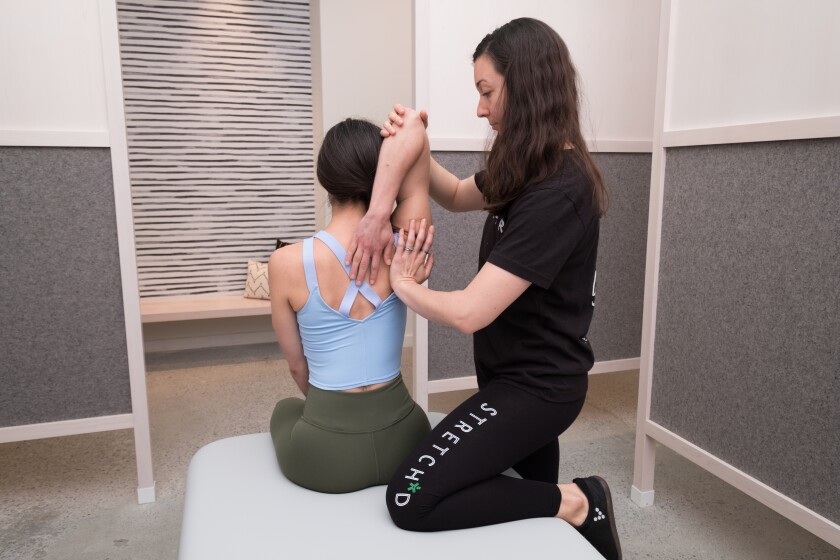Don’t forget to stretch. If you’ve heard it once, you’ve heard it way too many times. And yet, you still neglect muscle restoration and bolt during the five-minute cooldown at the end of a high-intensity fitness class. Now you can find out what you’ve been missing. Flexibility-focused classes were the fastest-growing group fitness trend in 2017 (per ClassPass), and specialized studios are popping up all over the country — including the nationwide franchise StretchLab, Chicago’s Stretch Chi, L.A.’s Stretch Pro and New York City’s Stretch Relief and Stretch*d.
What happens in a stretch class? Don’t worry, it’s not like high-school gym class when an apathetic teacher in a jumpsuit forced you to touch your toes. The group sessions (about $25 per class) more closely resemble a hybrid of resistance training and yoga. In a 25- to 75-minute class, a certified instructor takes you through a series of stretches on a mat designed to provide relief. You may also use a foam roller and lacrosse massage balls to coax muscles into relaxation. For a 1:1 assisted instruction (which will set you back about $125 per hour), the trainer will usually put you on a massage table and use specific therapeutic techniques, tools, positions and stretches to address any areas of tightness.

Why should I try this? Do it because you don’t want to negate a perfectly good workout. When you stretch, your muscles will feel looser right away. In the long run, according to research from the National Academy of Sports Medicine, a regular stretch may improve your range of motion, rid you of general aches, improve posture and increase blood flow and oxygen to the muscles — and help you relax, à la an amazing massage. A good stretch is also beneficial for anyone with a sedentary, screen-oriented lifestyle. After all, when you sit down all slouchy at your desk, your hips can turn tight and your back gets weak.
Can’t I just do this at home? Sure. A simple lunge in front of the TV, for example, can be a great way to loosen your hip flexors. It’s also cheaper. That said, taking a regular class, whether group or private, instills commitment and discipline. Stretch studios instructors also argue that you can get more out of a stretch by having a certified and licensed professional help you. But do your homework and ask questions about certifications or degrees before your first stretch session. And, as always, consult your doctor before undergoing a new activity.
What If I’m injured or already in pain? If that’s the case, then skip it and go directly to a doctor. Stretch studios don't sell themselves as replacements for physical therapy. “Come back when you're feeling better and we'll keep you from getting injured again,” StretchLab cofounder Saul Janson recently told Shape.com. FWIW, assisted studios such as StretchLab do recruit physical therapists to develop their technique.
What else do I need to know? Have realistic expectations. You’re not going to turn into a pretzel-legged gymnast thanks to a few bends. Also, it’s still unclear whether stretching can realistically boost athletic performance. While some research suggests it can help some athletes playing specific sports, there’s not enough data yet to say how much each of us should stretch to better perform any given physical activity. But stretching your muscles can still go a long way. Make that a looooooong way.










